Table of Contents
The squat is a basic complex exercise, which was so easy to perform as a child. But then you grew up and suddenly you couldn’t do it like you used to. The heels started to come off the ground and your rounded back reminded the shape of a turtle shell. At that point, other than the few punishments in gym class, you were able to successfully avoid this hard exercise. Later in life, however, you realised that if you want to build strong and nicely shaped legs and butt, it’s pretty hard to do without squats. Now try to give them a second chance and learn to squat properly again.
What are squats?
The squat is rightly known as the king of all exercises and has its place in almost every training routine. It is generally characterised by the movement of bending the knees and bending at the hips while maintaining an upright back. This movement mainly engages the muscles of the lower limbs as well as the middle of the body (core), effectively strengthening these areas.
You can do squats with your own weight or with a load, such as a barbell with plates, dumbbells or kettlebell. However, there are also a number of other squat variations such as the goblet, Bulgarian or single leg squat. Beginners and advanced athletes alike will find their own option that suits best.
5 reasons to do squats
Squats are great for versatility, as you can incorporate them into your warm-up as well as the main part of your workout. They are most often performed in the gym, but you can do them at home or in a hotel room. You can even save money on the go with squats. For example, in Romania (Cluj-Napoca) you can obtain a free public transport ticket for performing twenty squats in two minutes. What are some of the other benefits of squats?
1. Build functional strength
Our legs and buttocks can exert a lot of force and squats are a great way to not only test but also improve this skill. It’s no coincidence that they belong in the power triathlon along with the bench press and deadlift. According to studies, it has a comparable effect on the development of lower limb strength. [1]
Squatting can also pay off in everyday life. It uses the very muscles you need for everyday activities. Examples include sitting down and getting up from a chair, carrying heavy objects, walking upstairs or picking up a dropped pencil from the floor. By learning to engage the correct muscles through squatting, you reduce the risk of injury during everyday activities. At the same time, you will improve your balancing abilities and, thanks to a more functional core, you will also promote correct posture. [3]

2. Promote the growth of your lower limb muscles
However, this exercise will not only give you strength, but also toned legs and well-rounded buttocks. That’s why you’ll find some variation of the squat in almost every exercise routine focusing on shaping the glutes and thighs. You don’t have to do 100 squats a day with your own weight or other, often pointless challenges. Learn the correct technique and gradually increase the load using a barbell or dumbbells rather than adding dozens of reps endlessly. This will make training much more effective and also more fun. [2-3]
If strong and nicely shaped buttocks and legs are among your goals, you shouldn’t miss our article How to Tone and Shape Your Butt and Legs.
3. Improve in other sports as a result
Strong legs are important for powerlifters, runners, cyclists, footballers, hockey players and just about any other athlete you can think of. That’s why squats in various forms are also included in strength training of endurance athletes or players of team sports. For athletes, specifically sprinters, high and long jumpers, squats are even more significant in their training. They need the best possible rebound speed and dynamics. And squats with a jump or squats with a box jump help them to do this effectively. [4]
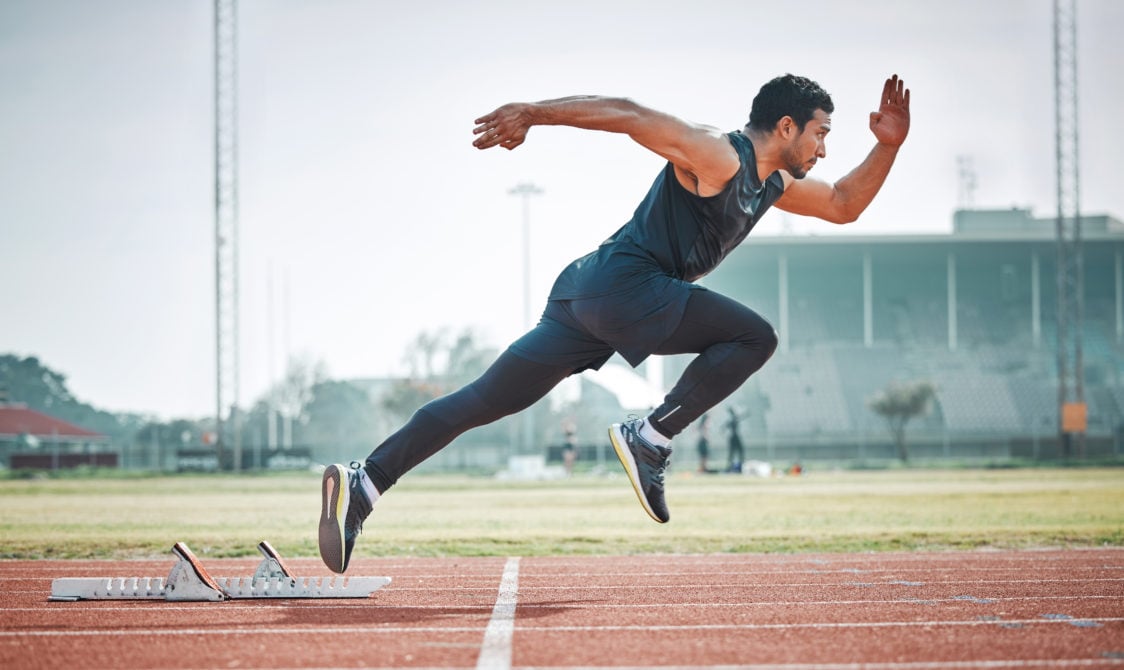
4. Support your mobility
As you learn to squat correctly and deeply enough, you will also develop mobility (range of motion) in your hips, knees and ankles. And believe me, it works better than some static stretching. Good mobility and flexibility in the joints is also beneficial in everyday life. In fact, it reduces the risk of injury during other physical activities. [5]
5. Burn more calories
Squats are a complex exercise that involves the glutes, thighs and many other muscles. They use a lot of energy in their function, which translates into more calories burned than when doing bicep raises and other single-joint exercises. Plus, after squatting with weights, just like after any strength training session, you can enjoy an extra load of calories burned (EPOC). An accelerated metabolism occurs due to recovery processes and continues for up to 72 hours after your workout. You will especially appreciate this benefit when losing weight. [6]
You can read more about the benefits of strength training in our article Diet, Cardio and Strength Training. What is Best for Weight Loss?

Which muscles do you use when doing squats?
Squats are a multi-joint exercise that can engage the muscles of almost your entire body. In the case of its basic form, it mainly involves the lower body.If you try other options, such as the overhead squat, you’ll also engage your shoulders, arms and back.
In a classic bodyweight squat, you primarily engage the:
- quadriceps (quadriceps femoris)
- muscles of the back of the thighs (hamstrings)
- gluteal muscles (gluteus maximus, medius and minimus)
- hip flexors
- large triangular muscle (adductor magnus)
- calf muscles (triceps surae)
- muscles of the deep spinal stabilisation system (DSS) or core (abdominal muscles, spinal extensors, diaphragm, pelvic floor muscles) [7-8]
In weighed squats in the case of other variations, you can engage your:
- back muscles
- shoulders
- arm muscles (biceps, triceps, forearms)
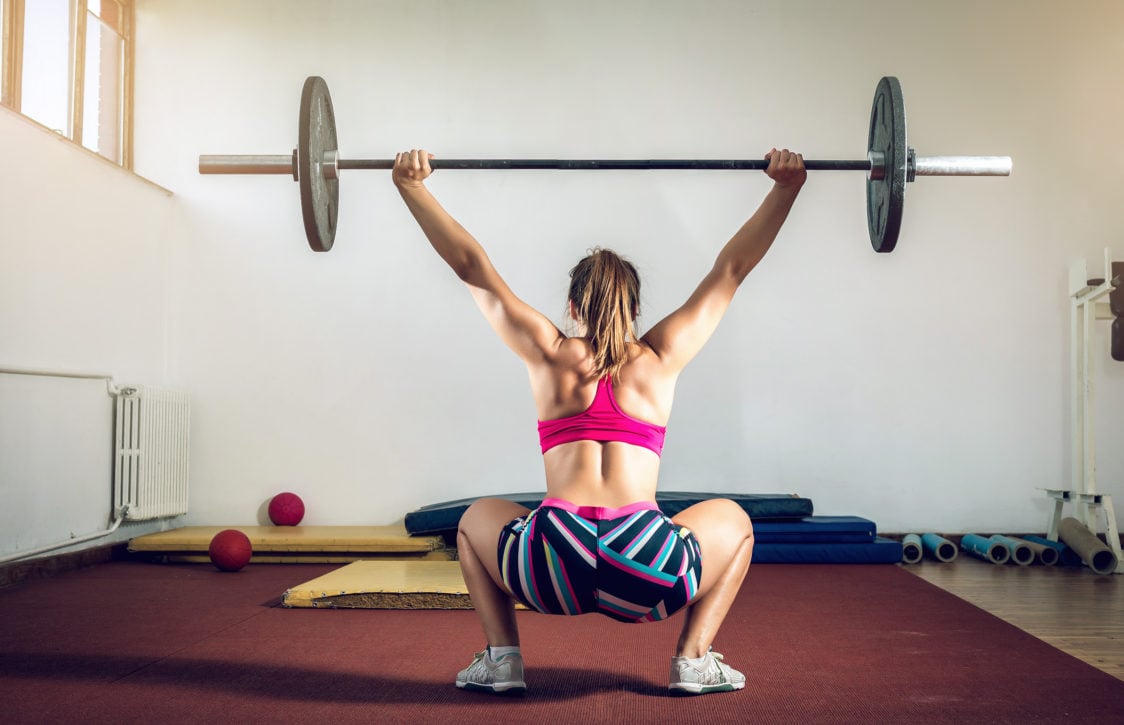
How to do squats correctly?
The road to a perfect squat can sometimes be long and harsh. Everyone’s body and athletic background is different, and not everyone learns to squat after a few visits to the gym. But the effort is always worth it. In the beginning, focus on proper technique. Feel free to practice with just your own weight, and gradually add barbell on which you will gradually load weights. But don’t overdo it with the rate at which you add weight to the barbell. Always keep in mind that correct execution takes precedence over the weight lifted.
If you are wondering how to set your training load according to your goal, find out in our article How Much Weight to Lift for Muscle Growth, Strength or Weight Loss?
How to warm up for squats?
Before you start to squat, you should not forget to warm up and move your whole body. After all, a large part of you sat at work or college before visiting the gym or home exercise corner. Therefore, you need to wake up your muscles a little and prepare your body for the load.
To warm up, just jump for 2–3 minutes with jumping jacks, jump rope or run on the spot. If you have a cardio machine (exercise bike, treadmill or rowing machine), feel free to warm up on it. Then move to an exercise mat. First, stretch the joints of your entire body, then focus more on your hips and knees, which you’ll need most during squats.
How to warm up your hips and knees?
- Hip rotation: Sit on the floor with your back straight. Bend your legs at the knees to an angle of approximately ninety degrees and rotate them so that they face the same side. Then, using the movement in your hips, lift them up and over to the opposite side. Your feet and buttocks remain on the mat. You can rest your arms behind your body or straighten them. Do this at least four times on each side. Gradually, as your hips relax, you should be able to move through a greater range of motion.
- Knee rotation in a lunge: Lunge forward with one leg, placing the knee of the back leg calmly on the mat and resting your palms on the front leg or the ground. Then begin to circle your front knee, first to one side, then the other. Try to get the knee in front of the top of the foot as you circle.
- Finally, do some squats with your own weight, or you can use a suspension trainer.
You can also do buttock exercises with a band in your warm-up to help activate your gluteal and leg muscles. You can find some exercises, for example, in our article 30 Full-Body Resistance Band Exercises.

What shoes should you wear for squats?
Proper squatting technique is also supported by the selection of appropriate footwear. For squatting with weights, solid shoes with flatter soles are ideal to ensure better stability. And if you’re really serious about strength training, invest in good quality weightlifting shoes that have a raised heel. This increases the range of motion in the ankle, allowing for a deeper, more stable squat. However, some people are more comfortable squatting in barefoot shoes or barefoot. While this allows maximum contact with the mat and greater freedom of foot movement, it also comes with less stability and a greater risk of injury.
What is the correct technique for squats?
Try to forget about instafriendly half squats with arched back, which are designed to do everything other than demonstrate a proper squat. Because a quality squat looks different. It goes deeper, the back stays in its natural curve, etc. Also, keep in mind that you are not participating in a squat competition. You’d rather do one correct squat than 5 sloppy ones at lightning speed. Let’s take a look at what a properly executed classic bodyweight squat should look like.
Basic position:
- Stand with a slight stance about shoulder width apart, keeping your weight on the entire surface of your foot.
- Keep your neck inline with the torso, maintaining a straight line from head to the hips, gaze forward, shoulders pulled down and back, the back in a natural curve and the chest open, facing forward.
- Extend your arms in front of your body or cross them over your chest for better balance. [9]
Execution:
- Inhale and move your pelvis backwards and downwards to do a squat. At the beginning of the movement, imagine that you are sitting on an invisible chair.
- Watch out for improper rounding and arching of the back in the thoracic and lumbar spine, as well as excessive buttock clenching.
- Choose the depth of the squat so that you can maintain your spine’s natural curvature. However, try to get at least to a position where your hips are lower than your knees (below the parallel).
- The axis of your knee, ankle and tip of your foot remain in the same line. Do not pull your knees inwards.
- Stay in this lower position for no more than 1 second. Otherwise, you may lose the necessary tension in your muscles.
- Exhale, straighten up smoothly by activating the muscles of the buttocks and the front of the thighs.
- Push the entire surface of your feet into the mat as if you were trying to push the ground away from you.
- Then repeat again.
- Keep your movement under control at all times. [9]
Breathing:
- Imagine you are a diver about to dive underwater.
- At the top, take a big breath into the abdomen to firm up your mid-body.
- Perform a squat and then begin to gradually straighten up while exhaling. However, some people may find it comfortable to exhale fully while in the top position.
- Then take another deep breath and follow it up with another repetition.
- You can use an exercise belt when lifting heavier weights. This will not only help you firm up your core, but can also teach you to breathe correctly right down into your abdomen. Just concentrate on extending it to all sides as you inhale.
With the squat technique it is also important to mention that each of you will be comfortable in a slightly different position. This is because of your different anatomy, such as the length of your thighs, as well as your overall mobility. Some people have a wider or narrower stance, some may be able to squat almost to the ground as in the ass to grass squat. At the same time, others will be just a few centimetres below the parallel of the thighs to the ground. However, with training, your technique will change and ideally improve.

What to watch out for when you squat?
You probably also still remember the days when a knee over the toes was considered a mistake. People mistakenly thought this is overloading the knees and just did half squats to be safe. Fortunately, nowadays, we have scientific evidence that this is a myth. Rather, a greater range of motion is a benefit to the knees (if they are healthy), and you can’t achieve proper squat technique other than by moving your knees past your toes. However, there are other errors that can not only rob you of results, but also put the health of your back and entire musculoskeletal system at risk. [10]
What are the most common mistakes made during squats and how to correct them?
- Arching the back: Excessive rounding of the thoracic or lumbar spine is an error one sees in the gym perhaps most often. Try to keep your back in a natural curve throughout the whole exercise, even at the cost of not doing as deep squat.
- Small range of motion: Half squats mean half the results, because a deeper squat engages many more muscles in the glutes and legs. A fair hip warm-up before a workout, or the use of squat wedge blocks, can help with better mobility.
- Forward or backward tilt: This is most often caused by poor weight distribution on the feet. Try to distribute the weight evenly over the entire feet surface.
- Lifting the heels off the ground: This is related to the previous point. The heels should be firmly on the ground all the time.
- Rolling your knees inward: This mistake can cause damage to your knee ligaments and puts unnecessary stress on your knees. Concentrate on keeping your knees facing outward at all times. An expander can help with this by placing it above your knees and trying to keep it under tension while squatting. [11]
In case you are into strength training and want to learn what the most common errors are, read our article Workout Mistakes that Almost Everybody Makes.
You might be interested in these products:
The most effective squat variations
Here are the best bodyweight or free weight squat variations. For each you will find the correct execution, common errors, and other modifications. You will also find out which muscles are involved the most. Keep in mind the basic rules for a correct squat, such as keeping your back in a natural curve, breathing correctly and activating your core.
Bodyweight squats
1. Air Squat
- Starting position: Stand with your feet slightly apart, about shoulder width apart. Your weight should be distributed evenly over the entire surface of your foot.
- Execution: Inhale and move your pelvis backwards and downwards to do a squat. Be careful not to misalign your back in the lumbar and thoracic regions of the spine. Choose the depth of the squat so that you can maintain the natural curvature of your spine. The axis of the knee, ankle and toe should remain in the same line. While exhaling, use the muscles of the buttocks and front of the thighs to straighten smoothly. Then repeat again.
- Common errors: Arching back, small range of motion, bending forward, knees inward, uneven weight distribution, falling forward on toe or back on the heel.
- Exercise variations: Single-leg squat, squat pumps, squat jumps.
- Focuses on: Quadriceps, buttocks.
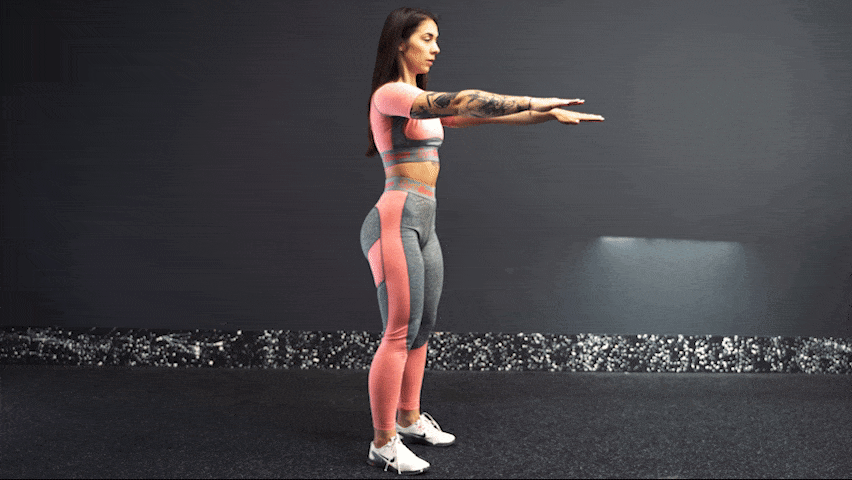
2. Jumping Air Squat
- Starting position: Stand with your legs slightly about shoulder-width apart. Your weight should be distributed evenly over the entire surface of your foot.
- Execution: Inhale and move your pelvis backwards and downwards to do a squat. Choose the depth of the squat so that you can maintain the natural curve of your spine. The axis of the knee, ankle and toe should remain in the same line. While exhaling, use the muscles of the buttocks and front of the thighs to perform a jump. In the top position, inhale, then return to the squat position and repeat the jump.
- Common errors: Arching back, small range of motion, bending forward, knees inward, uneven weight distribution, falling forward on toe or back on the heel.
- Exercise variation: In the upper phase, add another jump with the knees pulled to the chest (Tuck jump).
- Focuses on: Quadriceps, buttocks, calves.

3. Bulgarian Split Squat
- Starting position: Stand in front of a chair, bench or box with your feet hip-width apart. Place one foot on the box or bench behind you and place your hands by your sides.
- Execution: Inhale, bend the knee of the front leg and make a lunge. In the lower position, you can touch the knee of the back leg lightly to the mat. Then, inhale, straighten up and immediately follow up with another repetition. After you have done one set, switch legs and do the same exercise on the other side.
- Common errors: Small range of motion, poor coordination of movement.
- Exercise variation: Bulgarian split squat jump.
- Focuses on: Front and back of thighs, buttocks.
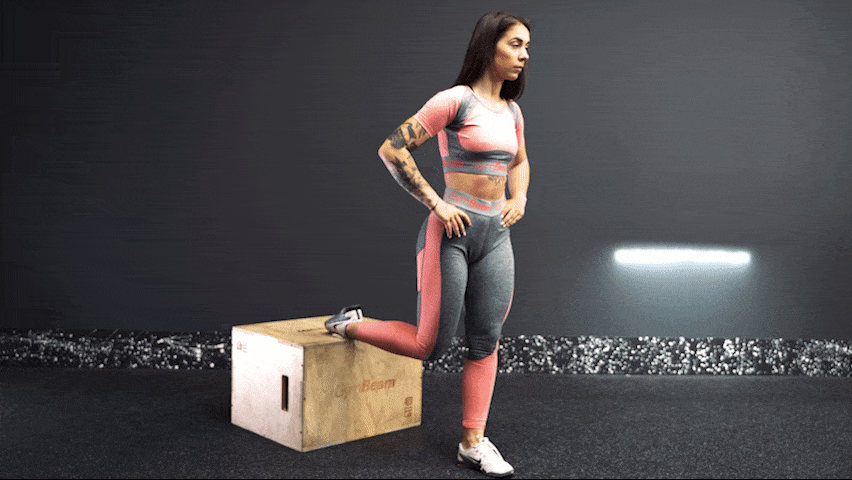
4. Wall Sit
- Starting position: Stand with your back against a wall, lean against it and go down into a squat position, ideally low enough to get your thighs parallel to the ground or even lower. Keep your feet flat on the floor and place your hands on your thighs.
- Execution: Breathe steadily and try to stay in this position for at least twenty seconds. This exercise is made a little more difficult if you don’t rest your hands on your thighs, but let them hang loosely alongside your body.
- Common errors: Short hold duration, low squat depth.
- Focuses on: Quadriceps, buttocks.

5. Single Leg Squat to Box
- Starting position: Stand with your back against a box (bench) with your feet hip-width apart. Extend your arms out to your sides.
- Execution: Transfer your weight to your right leg and lift your left leg off the ground. Inhale, bend the knee of the standing leg and squat down to the box. Touch the box with your buttocks and return to the starting position with an exhalation, using the muscles of your buttocks and thighs. Then follow up with another repetition and alternate legs.
- Common errors: Low range of motion, uncontrolled movement, arching back.
- Exercise variation: Squat on one leg without a box, with a horizontal bar, chair, rings or a suspension trainer.
- Focuses on: Quadriceps, buttocks.

Squats with weights
1. Barbell Back Squat
- Starting position: Set up your barbell with a suitably loaded weight on a weight rack (roughly at the height of your collarbones). Stand under the barbell with your feet about shoulder width apart. Place the barbell behind your neck and grasp it with both hands next to your shoulders, with your elbows pointing down. Activate your core, take the bar off the rack and step backwards.
- Execution: Inhale and move your pelvis backwards and downwards to do a squat. Choose the depth of the squat so that you are able to maintain the natural curve of your spine and are able to rise from this position. The axis of the knee, ankle and toe should remain in the same line. While exhaling, straighten smoothly by activating the muscles of the buttocks and front of the thighs. Then perform the next repetition. When you finish one set, return the barbell back onto the rack.
- Common errors: Back arching, low range of motion, forward bending, knees inward, uneven weight distribution, falling over on the toe or falling back on the heel, excessive or insufficient weight on the barbell.
- Exercise variation: Back squat with powerbag or water powerbag, back squat jump.
- Focuses on: Quadriceps, buttocks.
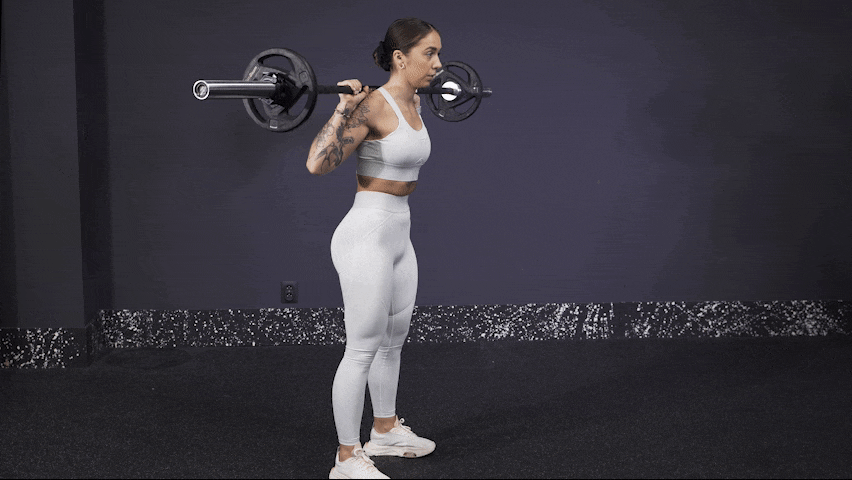
2. Front Squat
- Starting position: Set up your barbell with a suitably loaded weight on a weight rack (roughly at the height of your collarbones). Stand in front of the barbell with your feet about shoulder width apart. Grasp the barbell with both hands next to your shoulders with your elbows pointing forward (throughout the whole exercise). Activate the core, remove the bar from the rack and take a step backwards.
- Execution: Inhale and move your pelvis backwards and downwards to do a squat. Choose the depth of the squat so that you can maintain the natural curvature of your spine. The axis of the knee, ankle and toe should remain in the same line. While exhaling, straighten smoothly by activating the muscles of the buttocks and the front of the thighs. Then repeat again. When the set is complete, return the barbell back to the rack.
- Common errors: Rounding upper back, low range of motion, leaning forward, knees inward, uneven weight distribution, falling forward on the toe or back on the heel, excessive or insufficient weight on the barbell, dropping elbows.
- Exercise variations: Front squats with a dumbbell in front of chest, front squats on a Smith machine, Zercher squats.
- Focuses on: Quadriceps, buttocks.
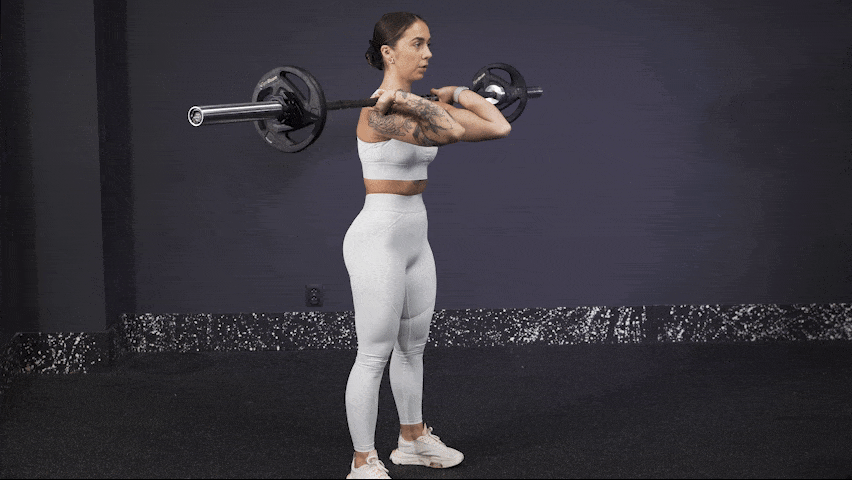
3. Dumbbell Bulgarian Split Squat
- Starting position: Stand with your back in front of a box or bench with your feet hip-width apart. Place one foot on the box or bench behind you. Grip dumbbells in both hands.
- Execution: Inhale, bend the knee of the front leg and make a lunge. In the lower position, you can touch the knee of the back leg lightly to the mat. Then, inhale, straighten up and immediately follow up with another repetition. After you have done one set, switch legs and do the same exercise on the other side.
- Common errors: Small range of motion, poor coordination of movement, excessive or insufficient load.
- Exercise variation: Bulgarian squats with kettlebell, barbell.
- Focuses on: Front and back of thighs, buttocks.
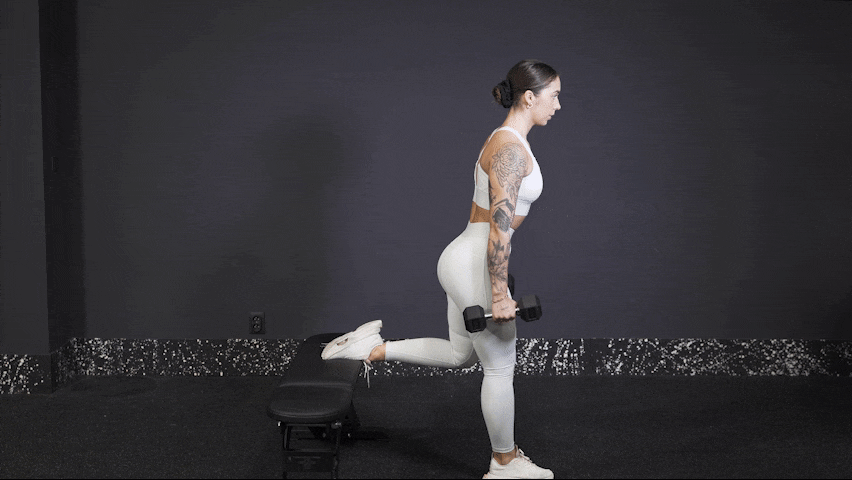
4. Dumbbell Sumo Squat
- Starting position: Stand in a wide stance with your toes pointing outwards. Lift the barbell by the handle or by one end (the plate part) and hold it with your arms outstretched and parallel to your body at all times.
- Execution: Inhale and bend your knees and do a squat. Exhaling, smoothly straighten up by activating the muscles of your buttocks and especially the inner thighs. Then repeat again.
- Common errors: Arching the back, small range of motion, bending forward, rolling the knees inward, unevenly distributed weight, excessive or insufficient load.
- Exercise variations: Sumo squat with kettlebell, with water powerball or with elevated legs (on two boxes or benches), pump sumo squat.
- Focuses on: Inner thighs, buttocks.
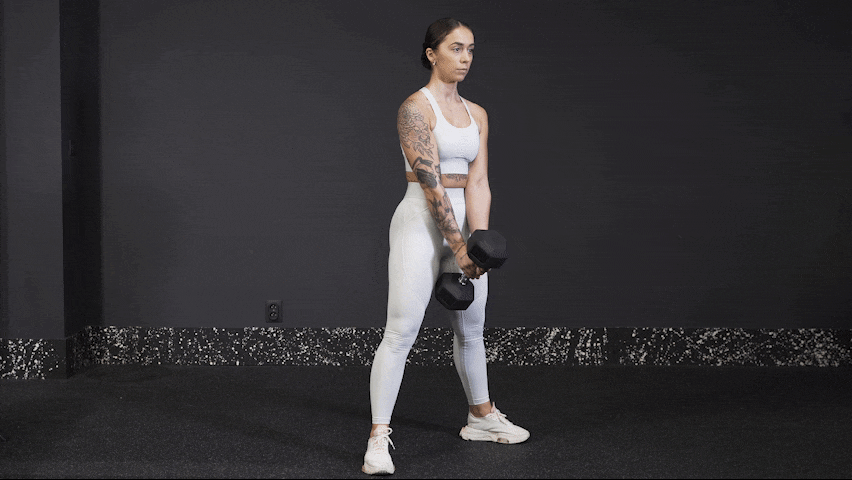
5. Overhead Squat
- Starting position: Set up your barbell with a suitably (less, for starters) loaded weight on a weight rack (about the height of your collarbones). Stand under it with your feet about shoulder width apart and grab it with a wide grip. Activate your mid-body, shoulders and arms and push the barbell above your head, straightening your arms at the elbows. Feel free to help yourself by adjusting your legs as well.
- Execution: Inhale and move your pelvis backwards and downwards to do a squat. Choose the depth of the squat so that you can maintain the natural curvature of your spine. The elbows should remain locked, the core of your body is activated and movement is controlled. Exhaling, straighten smoothly by activating the muscles of the buttocks and front of the thighs. Then perform the next repetition. When the set is complete, return the barbell back to the rack.
- Common errors: Arching the back, small range of motion, bending forward, inward rotation of the knees, uneven weight distribution, falling over on the toe or back on the heel, excessive weight on the barbell, bending elbows.
- Exercise variation: Dumbbell or kettlebell overhead squats.
- Focuses on: Quadriceps, buttocks, shoulders, arms, upper back.
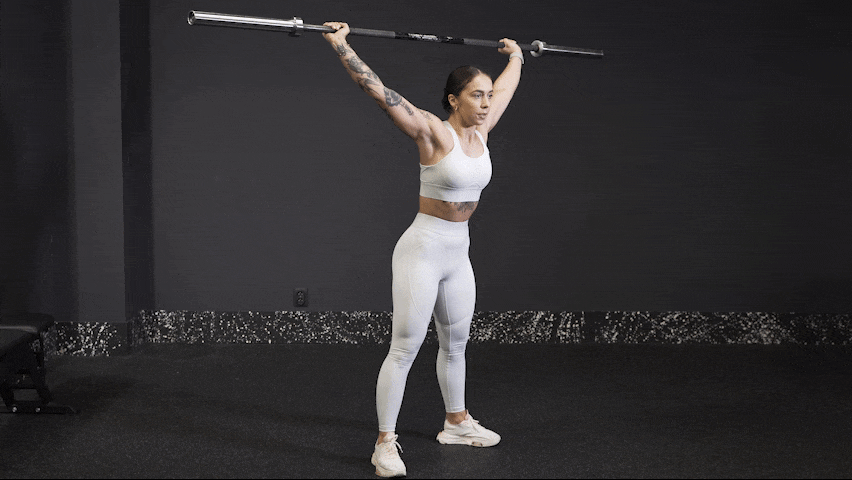
6. Dumbbell Goblet Squat
- Starting position: Stand with your feet about hip to shoulder width apart. Grasp the barbell with both hands at one side (the plate part) and lift it up in front of your chest so that it is parallel to your body.
- Execution: Inhale and move your pelvis backwards and downwards to do a squat. Hold the one arm in front of your body. Exhaling, smoothly straighten your back by activating the muscles of the buttocks and front of the thighs. Then repeat again.
- Common errors: Arching back, low range of motion, bending forward, knees inward, uneven weight distribution, falling over onto the toe or back on the heel, excessive or insufficient load.
- Exercise variation: kettlebell or slam ball goblet squats.
- Focuses on: Quadriceps, buttocks.
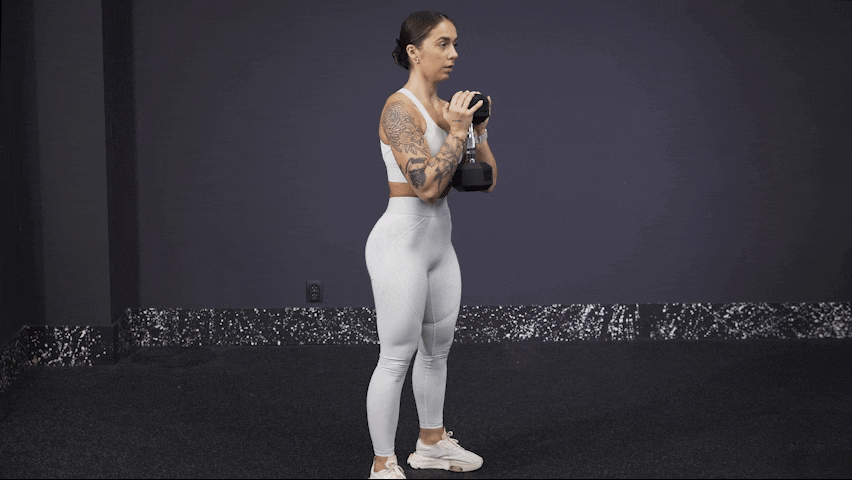
How to add squats to your training plan?
You can do this exercise at the gym, at home or on the workout playground. Just choose the option that best suits your goals and go for it. Some variations are suitable for both a warm-up and a main workout, however, you can add squats into in multiple types of workouts.
- Warm-up: Bodyweight squats or lunges are effective for warming up the body.
- Classic strength training: You can incorporate some variation of the weighted squat into your leg and full-body workout. This is a harder, more complex exercise, so it’s ideal for right at the beginning of your workout.
- Interval training: Bodyweight squats, jump squats or endurance squats are also suitable as part of HIIT, Tabata or circuit workout.
If you’re wondering which bodyweight exercises with you can incorporate into your training, you’ll find them in our article Get in Shape with These 12 Bodyweight Exercises.
What should you remember?
The squat is the king of exercises, whose benefits will convince you to include it in your training routine. It is an effective tool for increasing strength, muscle growth and burning calories. However, in order to squeeze the maximum benefits out of squats, you need to master the proper technique. Once you’ve mastered the basic squat, you can try other modifications such as the Bulgarian squat, front squat or even the sumo squat. These variations will add variety to your workout and help you effectively exercise your glutes, front, back and inner thighs.
If you liked this article and you’ve discovered new information, share it with your friends so they can learn to squat properly too.
[1] PMC. A Comparison Between the Squat and the Deadlift for Lower Body Strength and Power Training. – https://www.ncbi.nlm.nih.gov/pmc/articles/PMC7386153/
[2] PubMed. Effects of squat training with different depths on lower limb muscle volumes. – https://pubmed.ncbi.nlm.nih.gov/31230110/
[3] Boly, J. 12 Science-Backed Benefits of Squats You Should Know About. – https://barbend.com/benefits-of-squats/
[4] STACK. How Squats Benefits Your Performance. – https://www.stack.com/a/how-squats-benefits-your-athletic-performance/
[5] Legion Athletics. How to Improve Flexibility and Mobility for Squatting. – https://legionathletics.com/how-to-improve-flexibility-and-mobility-for-squatting/
[6] Dolezal, B. A., Potteiger, J. A., Jacobsen, D. J., & Benedict, S. H. Muscle damage and resting metabolic rate after acute resistance exercise with an eccentric overload. – https://doi.org/10.1097/00005768-200007000-00003
[7] ISSA. The Squat: Muscles Worked, Form, Variations, and More. – https://www.issaonline.com/blog/post/the-squat-muscles-worked-form-variations-and-more
[8] Silverberg, A. Squats: Muscles Worked (Complete Guide + How To Address Weaknesses). – https://powerliftingtechnique.com/squat-muscles/
[9] Runner’s World. Squats Are One of the Best Exercises for Runners. Learn How to Master Them. – https://www.runnersworld.com/training/a32256640/how-to-do-a-squat/
[10] Trust me, I’m a Physiotherapist. Squat myth – Knees should never go past your toes – https://trustmephysiotherapy.com/myth-knees-never-past-your-toes/
[11] Muscle & Fitness. 10 Common Squat Mistakes to Avoid. – https://www.muscleandfitness.com/workouts/leg-exercises/top-10-squat-mistakes/


Add a comment